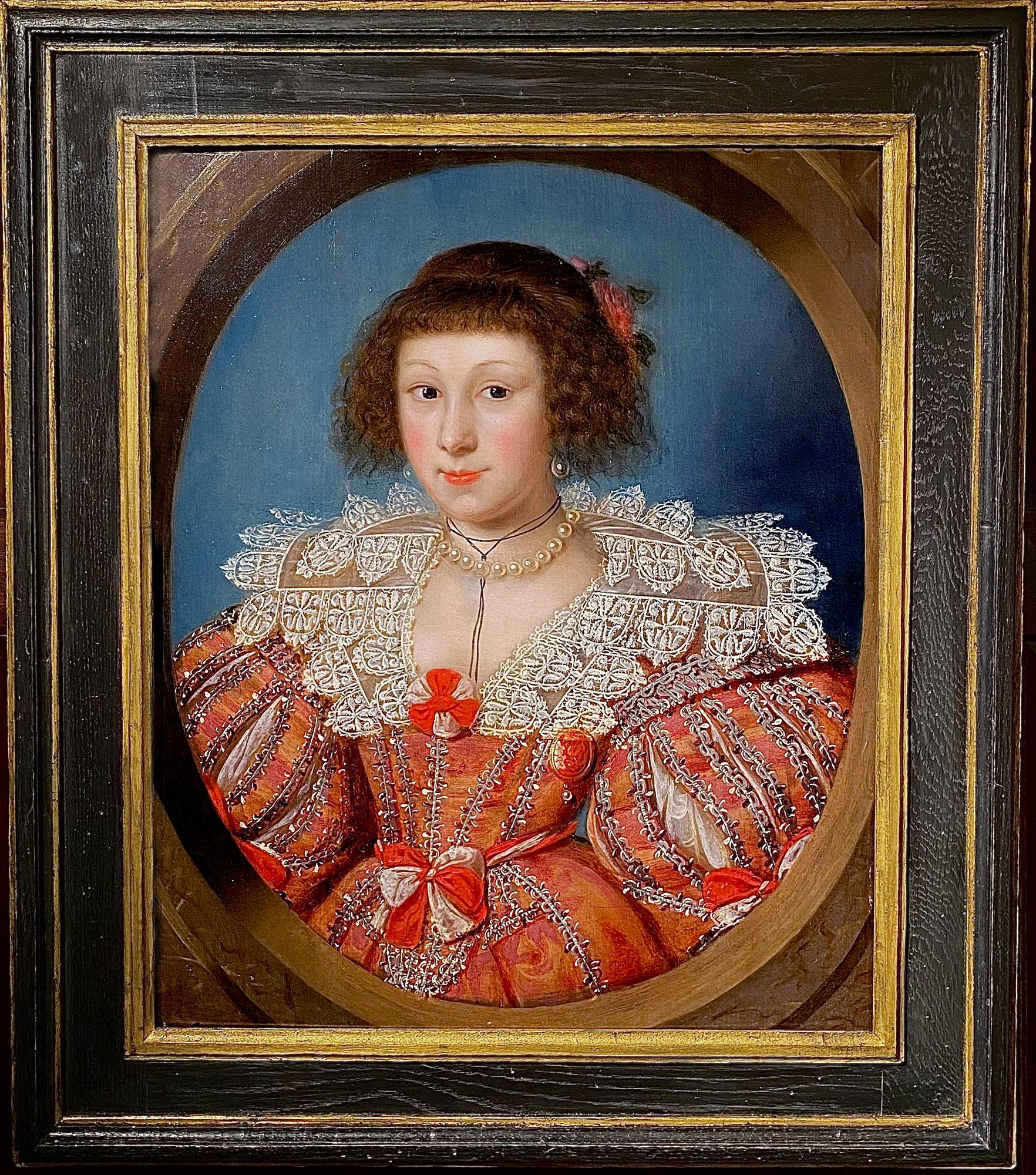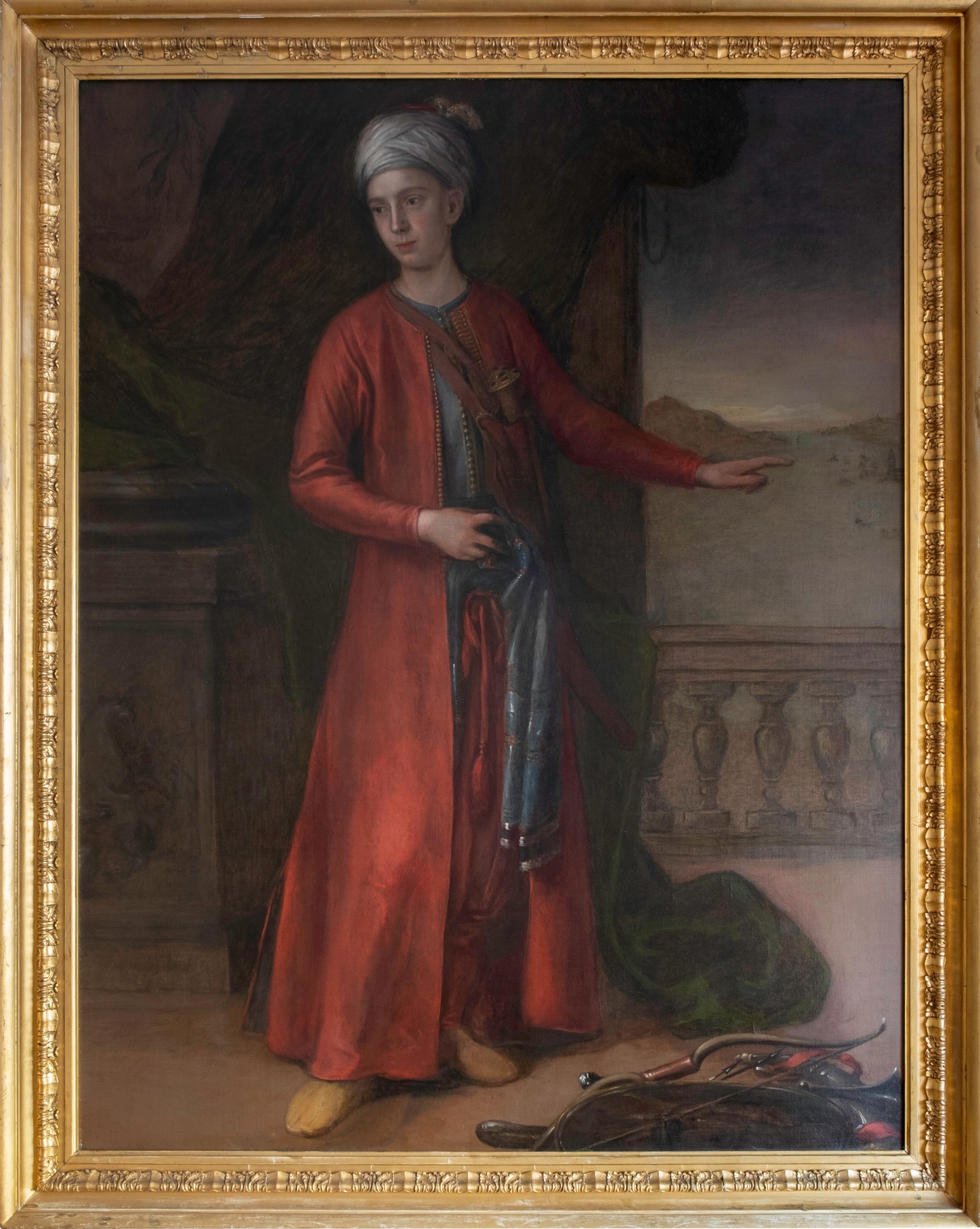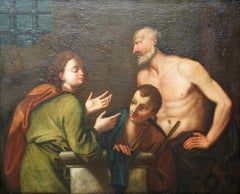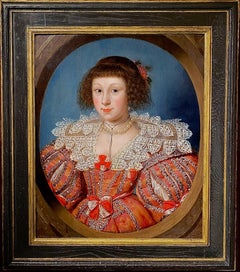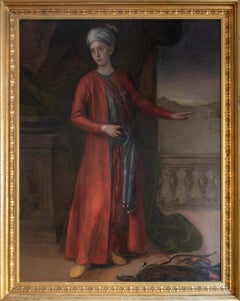
Portrait of Margaret Parker - British 18th century art Old Master oil painting
View Similar Items
Want more images or videos?
Request additional images or videos from the seller
1 of 17
Attributed to Henry Raeburn Portrait of Margaret Parker - British 18th century art Old Master oil painting1799
1799
About the Item
- Creator:Attributed to Henry Raeburn
- Creation Year:1799
- Dimensions:Height: 36 in (91.44 cm)Width: 28 in (71.12 cm)Depth: 2 in (5.08 cm)
- Medium:
- Movement & Style:
- Period:
- Condition:
- Gallery Location:London, GB
- Reference Number:1stDibs: LU85316417782
About the Seller
5.0
Platinum Seller
These expertly vetted sellers are 1stDibs' most experienced sellers and are rated highest by our customers.
1stDibs seller since 2018
400 sales on 1stDibs
More From This SellerView All
- Portrait of Robert Monypenny with Racket - British 18th century art oil paintingBy Thomas BeachLocated in London, GBThis lovely British 18th century Old Master oil painting is attributed to the manner of Thomas Beach. The sitter is Robert Monypenny (1771-1834) aged seven. He is the youngest son of...Category
18th Century Old Masters Portrait Paintings
MaterialsOil
- Joseph interpreting Dreams - Italian Old Master 17thC religious art oil paintingLocated in London, GBThis lovely 17th century Old Master religious oil painting is from the Italian School. The subject is Joseph in prison interpreting the dreams of Pharoah's Baker and Butler. The bars...Category
17th Century Old Masters Portrait Paintings
MaterialsOil
- Portrait of Anna de Hooghe - Flemish art Old Master portrait oil paintingBy Jacob Ferdinand Voet 1Located in London, GBThis strong Flemish Old Master portrait oil painting is attributed to Ferdinand Voet. The sitter is Anna De Hooghe, the fourth wife of artist Ludolf Bakhuizen (1631-1708), a German-born Dutch painter, draughtsman, calligrapher and printmaker. He was the leading Dutch painter of maritime subjects after Willem van de Velde the Elder and Younger left for England in 1672. He also painted portraits of his family and circle of friends. Painted circa 1660 Anna is standing profile but turned to the viewer/artist with her hand to her heart. She is set in a landscape at twilight. A really lovely painting and superb example of Dutch art. It is recorded in the RKD archives with N Maes signature LL - since removed through restoration. Provenance. The estate of George Way. Archive RKD Condition. Oil on canvas, 38 inches by 34 inches unframed and in good condition. Frame. Housed in a fine period carved frame, 46 inches by 42 inches framed and in good condition. Jacob Ferdinand Voet or Jakob Ferdinand Voet (1639-1689) was a Flemish portrait...Category
17th Century Old Masters Portrait Paintings
MaterialsOil
- Portrait of Mrs Anne Neale Tucker Lauzun - British Old Master art oil paintingBy Sir Henry RaeburnLocated in London, GBThis lovely British Old Master portrait oil painting is painted in the manner of Sir Henry Raeburn. Painted circa 1800, the sitter is Anne Neale Tucker Lauzun. She was born in St Geo...Category
Early 19th Century Old Masters Portrait Paintings
MaterialsOil
- Portrait of a Woman in a red Dress - French Old Master art oil paintingLocated in London, GBThis lovely French Old Master portrait oil painting is attributed to the circle of Jean Auguste Dominique Ingres. Painted circa 1810 it is a head and shoulders profile of a beautiful woman, resting her head on one hand. There is superb attention to detail and vibrant colouring. An excellent example of a French Old Master portrait of the period. Provenance. London estate. Condition. Oil on canvas, 15 inches by 12 inches unframed and in good condition. Frame. Housed in a gilt frame, 20 inches by 17 inches framed and in good condition. Jean-Auguste-Dominique Ingres (1780-1867) was a French Neoclassical painter. Ingres was profoundly influenced by past artistic traditions and aspired to become the guardian of academic orthodoxy against the ascendant Romantic style. Although he considered himself a painter of history in the tradition of Nicolas Poussin and Jacques-Louis David, it is his portraits, both painted and drawn, that are recognized as his greatest legacy. His expressive distortions of form and space made him an important precursor of modern art, influencing Picasso, Matisse and other modernists. Born into a modest family in Montauban, he travelled to Paris to study in the studio of David. In 1802 he made his Salon debut, and won the Prix de Rome for his painting The Ambassadors of Agamemnon in the tent of Achilles. By the time he departed in 1806 for his residency in Rome, his style—revealing his close study of Italian and Flemish Renaissance masters—was fully developed, and would change little for the rest of his life. While working in Rome and subsequently Florence from 1806 to 1824, he regularly sent paintings to the Paris Salon, where they were faulted by critics who found his style bizarre and archaic. He received few commissions during this period for the history paintings he aspired to paint, but was able to support himself and his wife as a portrait painter and draughtsman. He was finally recognized at the Salon in 1824, when his Raphaelesque painting of the Vow of Louis XIII was met with acclaim, and Ingres was acknowledged as the leader of the Neoclassical school in France. Although the income from commissions for history paintings allowed him to paint fewer portraits, his Portrait of Monsieur...Category
19th Century Old Masters Portrait Paintings
MaterialsOil
- Portrait of a Young Boy - British art 1780 Old Master male portrait oil paintingBy Joseph Wright of DerbyLocated in London, GBThis lovely Old Master portrait oil painting is attributed to the circle of Joseph Wright of Derby. Painted circa 1780 the painting is of a boy in a tunic and wide collar. A really c...Category
18th Century Old Masters Portrait Paintings
MaterialsOil
You May Also Like
- Portrait of a Lady with a ChiqueadorLocated in New York, NYProvenance: Torres Family Collection, Asunción, Paraguay, ca. 1967-2017 While the genre of portraiture flourished in the New World, very few examples of early Spanish colonial portraits have survived to the present day. This remarkable painting is a rare example of female portraiture, depicting a member of the highest echelons of society in Cuzco during the last quarter of the 17th century. Its most distinctive feature is the false beauty mark (called a chiqueador) that the sitter wears on her left temple. Chiqueadores served both a cosmetic and medicinal function. In addition to beautifying their wearers, these silk or velvet pouches often contained medicinal herbs thought to cure headaches. This painting depicts an unidentified lady from the Creole elite in Cuzco. Her formal posture and black costume are both typical of the established conventions of period portraiture and in line with the severe fashion of the Spanish court under the reign of Charles II, which remained current until the 18th century. She is shown in three-quarter profile, her long braids tied with soft pink bows and decorated with quatrefoil flowers, likely made of silver. Her facial features are idealized and rendered with great subtly, particularly in the rosy cheeks. While this portrait lacks the conventional coat of arms or cartouche that identifies the sitter, her high status is made clear by the wealth of jewels and luxury materials present in the painting. She is placed in an interior, set off against the red velvet curtain tied in the middle with a knot on her right, and the table covered with gold-trimmed red velvet cloth at the left. The sitter wears a four-tier pearl necklace with a knot in the center with matching three-tiered pearl bracelets and a cross-shaped earing with three increasingly large pearls. She also has several gold and silver rings on both hands—one holds a pair of silver gloves with red lining and the other is posed on a golden metal box, possibly a jewelry box. The materials of her costume are also of the highest quality, particularly the white lace trim of her wide neckline and circular cuffs. The historical moment in which this painting was produced was particularly rich in commissions of this kind. Following his arrival in Cuzco from Spain in the early 1670’s, bishop Manuel de Mollinedo y Angulo actively promoted the emergence of a distinctive regional school of painting in the city. Additionally, with the increase of wealth and economic prosperity in the New World, portraits quickly became a way for the growing elite class to celebrate their place in society and to preserve their memory. Portraits like this one would have been prominently displayed in a family’s home, perhaps in a dynastic portrait gallery. We are grateful to Professor Luis Eduardo Wuffarden for his assistance cataloguing this painting on the basis of high-resolution images. He has written that “the sober palette of the canvas, the quality of the pigments, the degree of aging, and the craquelure pattern on the painting layer confirm it to be an authentic and representative work of the Cuzco school of painting...Category
17th Century Old Masters Paintings
MaterialsCanvas, Oil
- Portrait of a Girl, 17th Century English School Old Masters OilBy Gilbert JacksonLocated in London, GBGilbert Jackson English Active: 1620 - 1650 Portrait of a Girl Oil on panel, signed upper left and Inscribed upper right Image size: 24 ½ x 20 inches Contemporary style hand made...Category
17th Century Old Masters Portrait Paintings
MaterialsOil
- 18th C. Portrait of the 4th Earl of Sandwich a View of Constantinople BeyondLocated in London, GBJohn Montagu, 4th Earl of Sandwich (13 November 1718 – 30 April 1792) Attributed to George Knapton (1698-1778) Dressed in the Turkish manner, stand...Category
18th Century Old Masters Figurative Paintings
MaterialsOil
- Portrait of Gentleman, Thomas Bruce, Earl of Elgin c.1638 Manor House ProvenanceLocated in London, GBTitan Fine Art present this picture which formed part of a historic collection of an English aristocratic family, Lord and Lady Sandys at their magnificent baroque and Regency Grade-...Category
17th Century Old Masters Portrait Paintings
MaterialsOil, Wood Panel
- Portrait of a Lady Diana Cecil, Countess of Elgin c.1638, Manor House ProvenanceLocated in London, GBTitan Fine Art present this picture which formed part of a historic collection of an English aristocratic family, Lord and Lady Sandys at their magnificent baroque and Regency Grade-...Category
17th Century Old Masters Portrait Paintings
MaterialsOil, Wood Panel
- 18th Century Oil Painting Portrait of Provost John Pitcairn of DundeeBy Sir Henry RaeburnLocated in London, GBThe pendant to the present portrait showing John Pitcairn's wife Jean, née Robertson, is in the Huntington Art Gallery, San Marino. Both works are datable to the 1790s. Pitcairn, who served as Provost of Dundee from 1782-84, a position his father-in-law also held from 1731-32, later sat to Raeburn for another portrait, dated to circa 1820, which is now in the Royal Scottish Academy, Edinburgh Sale of Christie's London: Wednesday, July 9, 2014 [Lot 00212] Old Master & British Paintings Day Sale Sold For 22,500 GBP Premium Provenance By descent from the sitter to his great-grandson, Ronald Andrew Pitcairn of Pitcullo; Christie's, London, 25 June 1904, lot 58 (200 gns. to Wallis). Alexander Reid, Glasgow. With Agnew's, London, where acquired by A.R. Wilson Wood, 7 April 1909; Christie's, London, 26 June 1914, lot 78 (850 gns. to Agnew). Anonymous sale; Christie's, London, 24 November 1972, lot 27 (320 gns.) Private collection, Dublin, Ireland Exhibition Edinburgh, Royal Scottish Academy, 1876, no. 256 Literature W. Armstrong, Sir Henry Raeburn, London, 1901, p. 110. J. Greig, Sir Henry Raeburn, R.A., His life and work with a catalogue of his pictures, London, 1911, p. 55. R. Asleson and S.M. Bennett, British Paintings at The Huntington, New Haven and London, 2001, p. 312, fig. 12 Sir Henry Raeburn FRSE RA RSA (4 March 1756 – 8 July 1823) was a Scottish portrait painter and Scotland's first significant portrait painter since the Union to remain based in Scotland. He served as Portrait Painter to King George IV in Scotland. Raeburn was born the son of a manufacturer in Stockbridge, on the Water of Leith: a former village now within the city of Edinburgh. He had an older brother, born in 1744, called William Raeburn. His ancestors were believed to have been soldiers, and may have taken the name "Raeburn" from a hill farm in Annandale, held by Sir Walter Scott's family. Orphaned, he was supported by William and placed in Heriot's Hospital, where he received an education. At the age of fifteen he was apprenticed to the goldsmith James Gilliland of Edinburgh, and various pieces of jewellery, mourning rings and the like, adorned with minute drawings on ivory by his hand, still exist. Soon he took to the production of carefully finished portrait miniatures; meeting with success and patronage, he extended his practice to oil painting, at which he was self-taught. Gilliland watched the progress of his pupil with interest, and introduced him to David Martin, who had been the favourite assistant of Allan Ramsay the Latter, and was now the leading portrait painter in Edinburgh. Raeburn was especially aided by the loan of portraits to copy. Soon he had gained sufficient skill to make him decide to devote himself exclusively to painting. George Chalmers (1776; Dunfermline Town Hall) is his earliest known portrait. In his early twenties, Raeburn was asked to paint the portrait of a young lady he had noticed when he was sketching from nature in the fields. Ann was the daughter of Peter Edgar of Bridgelands, and widow of Count James Leslie of Deanhaugh. Fascinated by the handsome and intellectual young artist, she became his wife within a month, bringing him an ample fortune. The acquisition of wealth did not affect his enthusiasm or his industry, but spurred him on to acquire a thorough knowledge of his craft. It was usual for artists to visit Italy, and Raeburn set off with his wife. In London he was kindly received by Sir Joshua Reynolds, the president of the Royal Academy, who advised him on what to study in Rome, especially recommending the works of Michelangelo, and gave Raeburn letters of introduction for Italy. In Rome he met his fellow Scot Gavin Hamilton, Pompeo Girolamo Batoni and Byers, an antique dealer whose advice proved particularly useful, especially the recommendation that "he should never copy an object from memory, but, from the principal figure to the minutest accessory, have it placed before him." After two years of study in Italy he returned to Edinburgh in 1787, and began a successful career as a portrait painter. In that year he executed a seated portrait of the second Lord President Dundas. Examples of his earlier portraiture include a bust of Mrs Johnstone of Baldovie and a three-quarter-length of Dr James Hutton...Category
18th Century Old Masters Figurative Paintings
MaterialsOil
Recently Viewed
View AllMore Ways To Browse
18th Century Portrait Oil Pair
Charles James Dress
Charles James Dresses
Stewart Of Scotland
18th Century Scottish Portrait
1799 Dress
Parker Henry Painting
Parker Dress
Attributed To Henry Raeburn
Knight And Lady
Queen Mary Portrait
Portrait Collar Dress
Countess Portrait
Portrait Countess Of
Frank Sinatra Paintings
Painting Of Sinatra
Portrait Of Lady 17th
Portrait Of Woman Scotland

